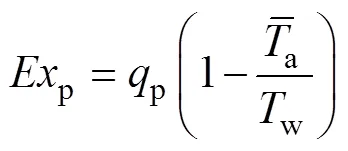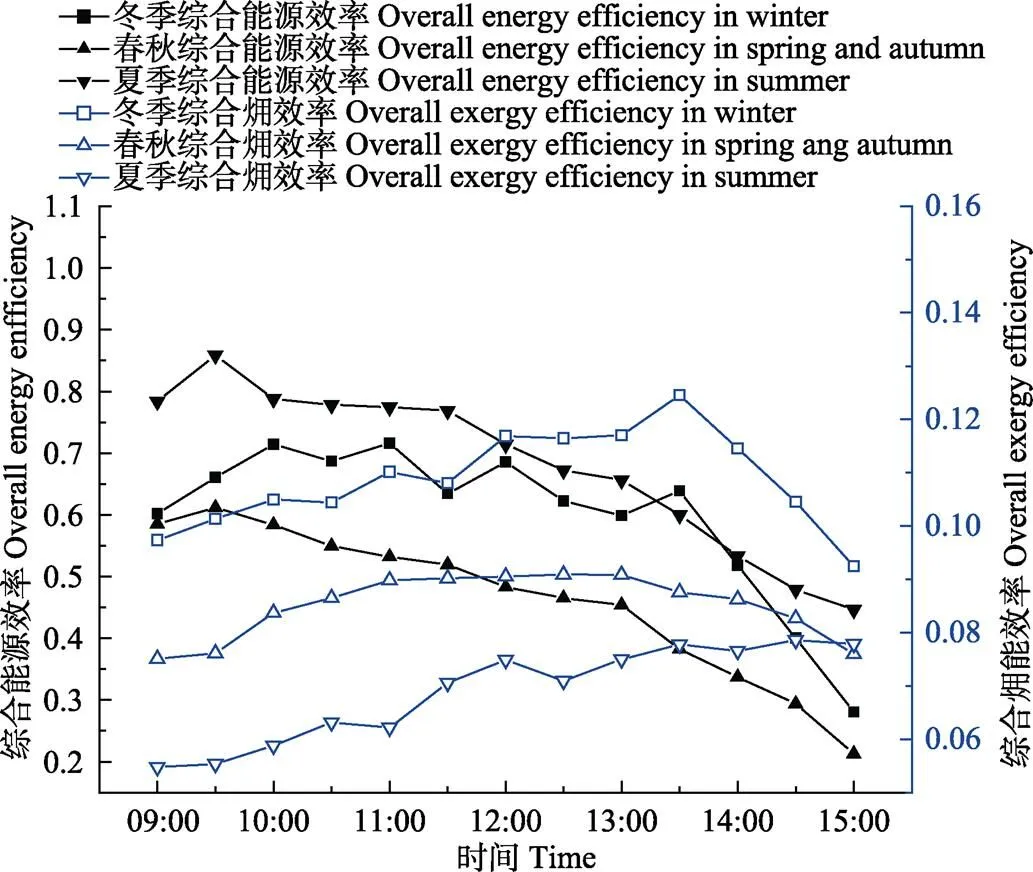太阳能光伏环路热管热水系统光电光热性能试验
2018-04-11侯平炜
李 洪,侯平炜,孙 跃
太阳能光伏环路热管热水系统光电光热性能试验
李 洪,侯平炜,孙 跃
(燕山大学建筑工程与力学学院,秦皇岛 066004)
为减少建筑热水能耗,该文研究了一种新型太阳能光伏环路热管热水系统。该系统将太阳能光伏光热利用与环路热管有机结合,并以电加热为辅助热源制备生活热水。搭建了室外测试平台,对该系统进行了典型工况及全天性能的测试研究,分析了循环工质充注量对系统性能的影响。结果显示,系统在环路热管运行模式下,夏季工况的光热效率和综合能源效率最高,日平均值分别为62.1%和68.1%;冬季工况的光电效率和综合㶲效率最高,日平均值分别为13.7%和10.9%。整套系统的综合能源效率和综合㶲效率略高于环路热管模式。30%充注量的工况更有利于系统光热效率和光电光热综合能源效率的提高,40%充注量的工况则有利于系统光电光热综合㶲效率的提高。该研究表明太阳能光伏环路热管热水系统在寒冷地区运行性能良好,为系统工质充注量的选择提供了参考依据。
太阳能;光伏;热管;试验;㶲
0 引 言
世界能源形势日趋严重,将太阳能应用于生活热水的制备越来越受到人们的关注[1-4]。近年来,一种新型太阳能应用技术——太阳能光伏光热(PV/T)技术——以其节能性、环境友好性等优势成为国内外众多学者研究的重点[5-7],研究内容主要包括设计更加高效的系统形 式[8-9]、讨论不同环境下某一特定系统的经济性与可行性等[10-11];研究方法包含数值模拟[12-15]、搭建试验台进行试验研究等[16-19]。通过学者们的不断探索和研究,太阳能PV/T技术日臻完善。在此基础上,一些学者[20-24]进一步提出将PV/T技术与环路热管相结合的供热系统,研究证明该种复合方案使太阳能光热、光电效率均有一定程度的提升。
Zhuang等[23]设计并制作了一个具有多种安装形式的环路热管太阳能热水系统,该系统可在近似水平或水平角度放置集热器时获得较高集热效率。台湾大学新能源中心[25]发明了一种新型太阳能热水器,这种热水器将环路热管敷设在热虹吸管背面,将热量从虹吸管传至水箱。
王璋元等[26]设计了一种新型环路热管太阳能热水系统,该系统将吸热热管镶嵌在聚苯乙烯泡沫板内,外部覆双层真空玻璃板,与传统太阳能热水系统相比具有一定节能减排效果。上述研究表明:结合了太阳能PV/T技术和环路热管技术的热水系统是对传统太阳能热水系统的一次拓展,更有利于推进建筑节能减排目标的实现。
在中国寒冷地区,传统平板式太阳能热水系统存在冬季结冰、太阳能光热效率较低等问题,但平板式太阳能集热器更容易实现建筑一体化。因此,本文拟通过试验研究的方式,对自主设计的一套太阳能光伏环路热管热水系统进行光电光热性能的测试研究,并进一步分析不同的制冷剂充注量对系统性能的影响。
1 太阳能环路热管热水试验系统的设计
1.1 试验平台简介
太阳能光伏环路热管热水系统如图1a所示,测试系统实物图如图1b所示。试验在秦皇岛市(39.95°N, 119.57°E)进行,集热器朝向正南布置,安装倾角为50°,集热器和冷凝器的安装高差为0.6 m,制冷剂(R22)充注量为系统结构总体积的40%。试验中采用均匀布置的热电阻Pt100监测吸热板温度、光伏电池板温度及水箱内水温等,测量数据通过安捷伦34970A进行采集。光伏电池板正负极连接固定阻值的电阻及开关,采用数字万用表监测电池板的输出电量。
1.2 系统的主要部件及运行原理
如图1a所示,该试验系统主要由PV/T集热/蒸发器、沉浸式垂直螺旋盘管冷凝器和即热式电加热器等部件组成。当太阳辐照度较高时,PV/T集热/蒸发器吸热管中的循环工质吸收太阳热能蒸发为气态工质,沿上升管到达冷凝器,在冷凝器中汽态工质在螺旋盘管内冷凝液化将热量传递给水箱中的水,从而达到加热热水的目的。当太阳辐照度不足时,开启即热式电加热器进行补充加热,以满足用户的用水需求。

图1 太阳能光伏环路热管热水系统及试验平台
将TBQ-2型总辐射表安装在与PV/T集热器相平行的位置,对集热器表面上的总太阳辐照度进行测量。
系统的关键部件PV/T集热/蒸发器采用管板式平板集热器,外框尺寸为2 000 mm × 1 000 mm × 80 mm,有效采光面积为1.87 m2,主要由玻璃盖板、吸热板、吸热管和单晶硅电池板等部件组成。光伏电池板由56块单晶硅电池串联组成,有效面积为0.875 m2,光伏覆盖率为46.8%,额定功率为140 W。在吸热板与电池板之间敷设TPT保护层作为绝缘层,在电池板正面贴一层减反透射膜,电池板、TPT与减反透射膜之间通过EVA连接。PV/T集热/蒸发器的详细设计参数如表1所示。

表1 PV/T集热/蒸发器设计参数

1.3 试验设计
1.3.1 环路热管模式下典型工况运行试验
分别在2016年12月9日、2017年4月28日和2017年7月12日进行了冬季、春秋和夏季工况下环路热管模式运行性能的试验研究。系统的工质充注率为30%。试验从上午08:00开始到下午15:00结束,共运行7 h。考虑到系统运行达到稳定需要一定时间,只选取09:00到15:00的数据进行分析。3种工况下的太阳辐照和室外空气温度如图2所示。其中,冬季工况的平均太阳辐照最高,为792 W/m2。春秋和夏季则分别为772和655 W/m2。冬季、春秋和夏季工况的平均室外空气温度分别为4.5、19.2和36.1 ℃。

图2 不同工况集热器表面太阳辐照度和室外温度的变化
1.3.2 系统全天性能试验
分别在2016年12月9日和2017年4月20日进行了系统全天性能的试验研究。其中,4月20日的日平均太阳辐照和室外空气温度分别为750 W/m2和26.7 ℃。系统的工质充注率为30%。系统运行时间段与环路热管模式下典型工况试验相同。
1.3.3 工况充注量对系统性能影响试验
在2017年4月21日和27日,分别以30%和40%的工质充注量进行了充注量影响试验。这2 d的日平均太阳辐照和室外空气温度相差不到2%,具备可比性。系统运行时间段与环路热管模式下典型工况试验相同。
2 主要性能分析方法
本文主要从热力学第一定律(能量分析)和热力学第二定律(㶲分析)2个方面分析了典型工况下环路热管运行模式和整套系统的运行性能。基于系统两方面的性能对比,进一步分析了循环工质充注量对系统性能的影响。
2.1 能量分析
基于热力学第一定律,环路热管运行模式的光电光热综合能源效率pvt可以按照式(1)计算[27]

式中为环路热管运行模式的光热效率,

pv为环路热管运行模式的光电效率,

为系统光伏电池的覆盖率,

sys为系统的综合能源效率,

式(1)~(5)中w为冷凝器得热量,W;p为电加热器输入水箱中的热量,W;pv为光伏电池的光电功率,W;为太阳辐照度,W/m2;C为PV/T蒸发器的有效集热面积,m2;pv为光伏电池的面积,m2;P为外界输入系统的电功率,W。
2.2 㶲分析
基于热力学第二定律,环路热管运行模式的光电光热㶲效率可以按照式(6)计算[26,28]

ξ为环路热管运行模式的光热㶲效率,

pv为环路热管运行模式的光电㶲效率,

式(6)~(8)中w为冷凝器得热量的㶲;pv为光伏电池的光电㶲;rad为单位面积太阳辐射的㶲,



sys为系统的综合㶲效率,



式(9)~(14)中p为电加热器输入水箱中的热量的㶲;power为外界输入系统电功率的㶲;a为室外空气温度;a为平均室外空气温度;sun为太阳辐照的温度,一般为6 000 K。
3 试验结果及分析
基于上述试验平台及理论分析方法,分析了典型工况下系统的运行性能,以及工质充注量对系统性能的影响。
3.1 环路热管模式下典型工况运行性能分析
环路热管模式下水温和光热效率的变化趋势如图3所示。可以看出系统在春秋及夏季工况下均能满足用户水温需求(取45 ℃),冬季则需启动电加热器继续加热。光热效率呈现先增大后减小的趋势,这是因为运行初期,太阳入射角逐渐减小,太阳辐照度逐渐升高,系统获得的热量也逐渐增加;随着水温的升高,光伏组件的温度升高,系统与环境间的热损失增大,而太阳辐照度的逐渐减弱导致系统得热量逐渐减少,光热效率有所降低。3种工况中夏季的日平均光热效率最高,为62.1%,春秋和冬季分别为40.2%和53.3%。

图3 不同季节环路热管模式下水箱内平均水温和光热效率的变化
由图4可知,在环路热管运行模式下,系统的综合能源效率和光热效率的变化趋于一致,春秋季、夏季和冬季日平均值分别为46.2%,68.1%和59.7%。这是因为综合能源效率为光热效率与光电效率的线性叠加,而系统的光热效率远大于光电效率。系统的综合㶲效率从低到高分别为夏季、春秋和冬季工况,其日平均值介于6.9%和10.9%之间。这是由于综合㶲效率主要受光电效率的 影响。
由上述分析可知,夏季工况下系统的光热效率和综合能源效率最优,而冬季工况下的光电效率和综合㶲效率最理想。3种工况系统运行性能均与传统太阳能PV/T热水系统可比[29]。

图4 不同季节环路热管模式下综合能源效率和综合㶲效率的变化
3.2 系统全天性能分析
为分析整套系统2种运行模式的综合运行性能,对4月20日和12月9日的试验数据进行对比分析,具体结果如表2所示。试验结果表明,环路热管模式下,12月9日和4月20日的日平均光热效率分别为53.3%和66.9%;日平均光电效率分别为13.7%和9.9%,且光伏电池的发电功率均在1.5 MJ以上。日平均光热㶲效率都较低,皆低于4.5%,而12月9日是4月20日的2.56倍,这主要是由于12月9日的平均水温和环境温度差别较大导致的。12月9日的光电㶲效率比4月20日高出18.03%,因此综合㶲效率比4月20日高41.56%。2 d的最终水温W,O均未达到用户的水温需求,需启动电加热器继续加热,12月9日和4月20日分别耗电1.7和0.8 kWh。由于系统整体的综合能源效率和综合㶲效率需要考虑输入的电能和输入电能后得热量的增加,其值略高于环路热管模式。12月9日系统整体综合能源效率和综合㶲效率比环路热管模式分别高出12.2%和7.3%;4月20日分别高出7.1%和18.2%。

表2 环路热管模式与系统整体全天性能分析
3.3 工质充注量对系统性能的影响
工质的充注量对系统的光热性能有较大影响,如图5所示。试验结果显示,在2种充注量工况下,环路热管模式的最终水温均达到了用户水温的需求。可以看出,30%充注量的系统光热效率明显高于40%充注量的工况,2种工况的日平均值分别为55.5%和40.2%。这是由于试验过程中30%充注量的系统吸热板温度更高,从而确保吸热管内工质可以吸收更多热量;此外,较高的吸热板温度使吸热管出口的工质过热度更高,进一步提高了系统的换热性能。
由图6可知,30%充注量工况下综合能源效率较大,平均值为55.0%,最高值达到了59.3%,40%充注量工况下综合能源效率的平均值为46.2%。同时,绝大部分时间内,30%充注量工况下综合㶲效率低于40%充注量工况下,2种工况的平均值分别为5.2%和8.5%。这主要是因为40%充注量的平均电池板温度为48.2 ℃,低于30%充注量工况下的51.4 ℃,因此40%充注量工况的光电效率较高,综合㶲效率也较高。
3.4 误差分析




其中为测试期间所选择的数据点数量。依据上述算法,独立参数太阳辐照度和冷却水温度W的日平均相对误差分别为1.3%和2.06%;非独立参数环路热管模式光电效率pv和光热效率t的日平均相对误差分别为0.28%和6.19%。试验过程中所有参数误差均在工程允许范围内。

图6 不同充注量工况下系统综合㶲效率和综合能源效率的变化
4 结 论
本文以太阳能光伏环路热管热水系统为研究对象,研究分析了系统在冬季、春秋和夏季3种典型工况下的运行性能,以及循环工质充注量对系统运行的影响。主要结论如下:
1)由环路热管模式下典型工况的分析可知,夏季工况下系统的光热效率和综合能源效率最高,日平均值分别为62.1%和68.1%;而冬季工况下光电效率和综合㶲效率则最优,日平均值为13.7%和10.9%。3种工况下所研究系统运行性能均与传统太阳能PV/T热水系统可比。
2)由全天性能分析可知,系统只运行环路热管模式不能满足用户水温需求,需进一步启动电加热器。12月9日的系统整体综合能源效率和综合㶲效率比环路热管模式分别高出12.2%和7.3%;4月20日分别高出7.1%和18.2%。
3)由循环工质充注量的影响分析可知,从热力学第一定律的角度出发,30%充注量的工况更有利于系统光热效率和综合能源效率的提高,其平均值分别为55.5%和55.0%;从热力学第二定律的角度出发,40%充注量的工况更有利于系统综合㶲效率的提高,其平均值为8.5%。
[1] Li Hong, Yang Hongxing. Potential application of solar thermal systems for hot water production in Hong Kong[J]. Applied Energy, 2009, 86(2): 175-180.
[2] Shukla A, Buddhi D, Sawhney R L. Solar water heaters with phase change material thermal energy storage medium: A review[J]. Renewable and sustainable Energy Reviews, 2009, 13(8): 2119-2125.
[3] Fuentes E, Arce L, Salom J. A review of domestic hot water consumption profiles for application in systems and buildings energy performance analysis[J]. Renewable and Sustainable Energy Reviews, 2018, 81: 1530-1547.
[4] An Jingjing, Yan Da, Deng Guangwei, et al. Survey and performance analysis of centralized domestic hot water system in China[J]. Energy and Buildings, 2016, 133: 321-334.
[5] Wang Zhangyuan, Yang Wansheng. A review on loop heat pipe for use in solar water heating[J]. Energy and Buildings, 2014, 79: 143-154.
[6] Tonui J K, Tripanagnostopoulos Y. Improved PV/T solarcollectors with heat extraction by forced or natural air circulation[J].Renew Energy, 2007, 32(4): 613-637.
[7] Amoria Karima E, Taqi Al-Najjar Hussein M. Analysis of thermal and electrical performance of a hybrid (PV/T) air based solar collector for Iraq[J]. Applied Energy, 2012, 98: 384-395.
[8] Wang Zhangyuan. Investigation of a Novel Façade-based Solar Loop Heat Pipe Water Heating System[D]. University of Nottingham, 2012: 131-135.
[9] Zhao Xudong, Wang Zhangyuan, Tang Qi. Theoretical investigation of a novel loop heat pipe solar water heating system for use in Bingjing, China[J]. Applied Therm Eng, 2010, 30: 2526-2536.
[10] Zhang Xingxing, Shen Jingchun, Xu Peng, et al. Socio- economic performance of a novel solar photovoltaic/ loop-heat-pipe heat pump water heating system in three different climatic regions[J]. Applied Energy, 2014, 135: 20-34.
[11] Wang Zhangyuan, Zhang Xingxing, Yang Wansheng. Experiment investigation of the indoor thermal comfort of the public buildings in the typical subtropical climatic region[J]. Applied Mechanics and Materials, 2014p: 588-592.
[12] Huang B J, Lin T H, Hung W C, et al. Performance evaluation of solar photovoltaic/thermal systems[J]. Sol Energy, 2001, 70: 443-448.
[13] He Wei, Hong Xiaoqiang, Zhao Xudong, et al. Theoretical investigation of the thermal performance of a novel solar loop-heat-pipe facade-based heat pump water heating system[J]. Applied Energy, 2014, 77: 180-191.
[14] Zhang Xingxing, Zhao Xudong, Xu Jihuan, et al. Characterization of a solar photovoltaic/loop-heat-pipe heat pump water heating system[J]. Applied Energy. 2013, 102: 1229-1245.
[15] Ji Jie, He Hangfeng, Tintai Chow, et al. Distributed dynamic modeling and experimental study of PV evaporator in a PV/T solar-assisted heat pump. Int J heat Mass Transfer. 2009, 52: 1365-1373.
[16] Pei Gang, Fu Huide, Zhang Tao, et al. A numerical and experimental study on a heat pipe PV/T system. Solar Energy. 2011, 85: 911-921.
[17] Pei Gang, Zhang Tao, Yu Zhi, et al. Comparative study of a novel heat pipe photovoltaic/thermal collector and a water thermosiphon photovoltaic/thermal collector[J]. Journal of Power and Energy, 2011, 225(3): 271-278.
[18] Zhang Xingxing, Zhao Xudong, Shen Jingchun, et al. Design, fabrication and experimental study of a solar photovoltaic/ loop-heat-pipe based heat pump system[J]. Solar Energy, 2013, 97: 551-568.
[19] Zhang Xingxing, Zhao Xudong, Shen Jingchun, et al. Dynamic performance of a novel solar photovoltaic/loop- heat-pipe heat pump system[J]. Applied Energy, 2014, 114: 335-352.
[20] Wang Z, Duan Z, Zhao X, et al. Dynamic performance of a facade-based solar loop heat pipe water heating system[J]. Solar Energy, 2012, 86: 1632-1647.
[21] Zhang Xingxing, Zhao Xudong, Stefan Smith, et al. Review of R&D progress and practical application of the solar photovoltaic/thermal (PV/T) technologies[J]. Renew Sust Energy Rev, 2012, 16(1): 599-617.
[22] Li Hong, Sun Yue. Operational performance study on a photovoltaic loop heat pipe/solar assisted heat pump water heating system[J]. Energy and Buildings, 2018, 158: 861-872.
[23] Zhuang Jun. Loop heat pipes for solar energy water heater[P]. People’s Republic of China Patent No. 101922814A, 2010.
[24] Deng Yuechao, Quan Zhenhua, Zhao Yaohua, et al. Experimental research on the performance of household-type photovoltaic–thermal system based on micro-heat-pipe array in Beijing[J]. Energy Conversion and Management, 2015, 106: 1039-1047.
[25] 新型模组式太阳能热水器已开发成功[C]. 台大新能源中心通讯,1996.
[26] 王璋元,杨晚生,赵旭东.新型环路热管太阳能热水系统节能减排评估[J]. 太阳能学报,2014,35(5):825-829. Wang Zhangyuan, Yang Wansheng, Zhao Xudong. Energy- saving and carbon emission reduction evaluations of a novel loop heat pipe solar water heating system[J]. Acta Energiae Solaris Sinica, 2014, 35(5): 825-829. (in Chinese with English abstract)
[27] Chow T T, Pei G., Fong K F, et al. Energy and exergy analysis of photovoltaic–thermal collector with and without glass cover[J]. Applied Energy, 2009, 86: 310-316.
[28] 张龙灿,裴刚,张涛,等. 新型光伏—太阳能环形热管/热泵复合系统[J]. 化工学报,2014,65(8):3228-3236. Zhang Longcan, Pei Gang, Zhang Tao, et al. A new photovoltaic solar-assisted loop heat pipe/heat-pump system[J]. CIESC Journal, 2014, 65(8): 3228-3236. (in Chinese with English abstract)
[29] Chow T T. A review on photovoltaic/thermal hybrid solar technology[J]. Applied Energy 2010, 87: 365-379.
Photoelectricity and photothermal performance experiment on solar photovoltaic/loop-heat-pipe water heating system
Li Hong, Hou Pingwei, Sun Yue
(066004,)
The aim of this paper was to present a dedicated experimental investigation of the thermal and electrical performance of a solar photovoltaic/loop-heat-pipe water heating system. The studied system was the combination of the loop heat pipe and the solar photovoltaic/thermal technology, which was assisted by the electric water heater to product hot water for residential buildings in cold zone. The proposed system could work in 2 operational modes, and the operational modes were mainly determined by the variation of solar radiation. When solar radiation was high, the system operated in the photovoltaic/loop-heat-pipe mode; when solar radiation was low or it was a rainy day, the electric water heater was turned on to heat water to match the preset value. The experimental platform for the solar photovoltaic/loop-heat-pipe water heating system was built and a series of experiments under real weather conditions were conducted. Based on test results, energy and exergy performance of the studied system under typical working condition was analyzed. And the typical working conditions include the transitional season condition, the summer condition and the winter condition. Besides, energy and exergy performance of the system on the specific 2 days was discussed and compared. What was more, the impact of the refrigerant charge quantity on the operating performance was analyzed. Therefore, main content of this paper was composed of energy and exergy performance analyses under typical working conditions and selected full days. The experimental results in the photovoltaic/loop-heat-pipe mode were analyzed in terms of the solar thermal efficiency, the photovoltaic efficiency, the overall energy efficiency and the overall exergy efficiency. For the solar thermal efficiency and overall energy efficiency, the experimental results were the highest in summer, and the daily average values were 62.1% and 68.1% respectively. For the photovoltaic efficiency and overall exergy efficiency, the experimental results were the highest in winter, and the daily average values of them were 13.7% and 10.9% respectively. The whole system performance considered the performance of 2 operational modes, and therefore the overall energy and exergy efficiency of the whole system were a litter higher than those of the mode of photovoltaic/loop-heat-pipe. In this paper, the experimental results of April 20thand December 9thwere chosen to analyze full-day performance of this system, and the solar thermal efficiency and overall energy efficiency were higher on April 20th, while the photovoltaic efficiency and overall exergy efficiency of full-day performance were higher on December 9th. This paper also discussed the system performance with different refrigerant charge quantities in similar ambient environment. And the results showed that 30% refrigerant charge quantity was conducive to the improvement of solar thermal efficiency and overall energy efficiency of this system and 40% refrigerant charge quantity was conducive to the improvement of electrical efficiency and overall exergy efficiency of this system.
solar energy; photovoltaic; heat pipe; experiment; exergy
李 洪,侯平炜,孙 跃. 太阳能光伏环路热管热水系统光电光热性能试验[J]. 农业工程学报,2018,34(7):235-240. doi:10.11975/j.issn.1002-6819.2018.07.030 http://www.tcsae.org
Li Hong, Hou Pingwei, Sun Yue. Photoelectricity and photothermal performance experiment on solar photovoltaic/loop-heat-pipe water heating system[J]. Transactions of the Chinese Society of Agricultural Engineering (Transactions of the CSAE), 2018, 34(7): 235-240. (in Chinese with English abstract) doi:10.11975/j.issn.1002-6819.2018.07.030 http://www.tcsae.org
2017-10-18
2018-03-01
河北省自然科学基金青年基金项目(E2015203166);燕山大学青年教师自主研究计划课题理工A类项目(15LGA010)
李洪,副教授,博士,研究方向为复合热源热泵技术及太阳能光热综合利用技术。Email:be_leecandy@163.com。
10.11975/j.issn.1002-6819.2018.07.030
TE0
A
1002-6819(2018)-07-0235-06
